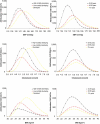Distribution of major health risks: findings from the Global Burden of Disease study
- PMID: 15526049
- PMCID: PMC523844
- DOI: 10.1371/journal.pmed.0010027
Distribution of major health risks: findings from the Global Burden of Disease study
Abstract
Background: Most analyses of risks to health focus on the total burden of their aggregate effects. The distribution of risk-factor-attributable disease burden, for example by age or exposure level, can inform the selection and targeting of specific interventions and programs, and increase cost-effectiveness.
Methods and findings: For 26 selected risk factors, expert working groups conducted comprehensive reviews of data on risk-factor exposure and hazard for 14 epidemiological subregions of the world, by age and sex. Age-sex-subregion-population attributable fractions were estimated and applied to the mortality and burden of disease estimates from the World Health Organization Global Burden of Disease database. Where possible, exposure levels were assessed as continuous measures, or as multiple categories. The proportion of risk-factor-attributable burden in different population subgroups, defined by age, sex, and exposure level, was estimated. For major cardiovascular risk factors (blood pressure, cholesterol, tobacco use, fruit and vegetable intake, body mass index, and physical inactivity) 43%-61% of attributable disease burden occurred between the ages of 15 and 59 y, and 87% of alcohol-attributable burden occurred in this age group. Most of the disease burden for continuous risks occurred in those with only moderately raised levels, not among those with levels above commonly used cut-points, such as those with hypertension or obesity. Of all disease burden attributable to being underweight during childhood, 55% occurred among children 1-3 standard deviations below the reference population median, and the remainder occurred among severely malnourished children, who were three or more standard deviations below median.
Conclusions: Many major global risks are widely spread in a population, rather than restricted to a minority. Population-based strategies that seek to shift the whole distribution of risk factors often have the potential to produce substantial reductions in disease burden.
Conflict of interest statement
Figures


References
-
- World Health Organization. Geneva: World Health Organization; 2002. The world health report 2002: Reducing risks, promoting healthy life; 250 pp. - PubMed
-
- Ezzati M, Lopez AD, Rodgers A, Vander Hoorn S, Murray CJ Comparative Risk Assessment Collaborating Group. Selected major risk factors and global and regional burden of disease. Lancet. 2002;360:1347–1360. - PubMed
-
- Rodgers A, Lawes C, MacMahon S. The global burden of cardiovascular disease conferred by raised blood pressure. Benefits of reversal of blood pressure-related cardiovascular risk in Eastern Asia. J Hypertens. 2000;18:S3–S5. - PubMed
-
- Cook NR, Cohen J, Hebert P, Taylor JO, Hennekens CH. Implications of small reductions in diastolic blood pressure for primary prevention. Arch Intern Med. 1995;155:701–709. - PubMed
-
- Murray CJL, Lauer JA, Hutubessy RCW, Niessen L, Tomijima N, et al. Effectiveness and costs of interventions to reduce systolic blood pressure and cholesterol: A global and regional analysis on reduction of cardiovascular-disease risk. Lancet. 2003;361:717–725. - PubMed
Publication types
MeSH terms
Grants and funding
LinkOut - more resources
Full Text Sources
Other Literature Sources
Medical

